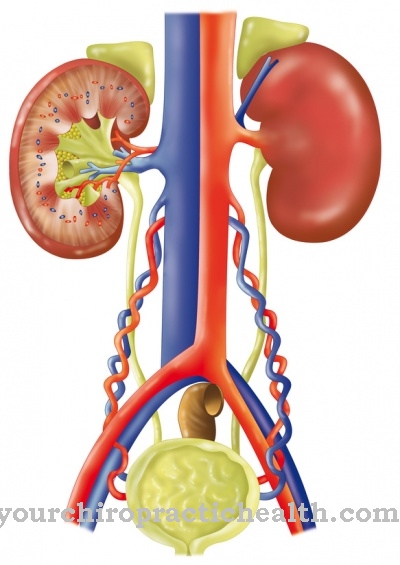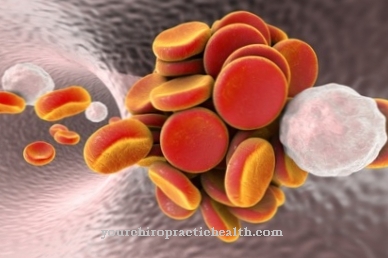Methicillin is an antibiotic from the penicillin group of active ingredients. It is only effective against gram-positive bacteria such as Staphylococcus aureus and therefore has a very narrow spectrum of activity. Today it is no longer used as a drug, but is only used as an indicator substance in MRSA resistance tests.
What is methicillin?

Methicillin is considered to be the first penicillin in which resistance to the penicillinase of bacteria was established. The characteristic feature of methicillin is a beta-lactam ring, which is sterically shielded against external destruction. The enzyme penicillinase breaks down this beta-lactam ring in the penicillins, rendering them ineffective.
However, methicillin has a side chain that prevents the enzyme from accessing the beta-lactam ring. Therefore, methicillin raised many hopes of being an effective penicillin against gram-positive bacteria. In 1959 it was developed by the pharmaceutical company "Beecham". In the beginning, infections with the bacterium Staphylococcus aureus could be combated effectively. However, more and more resistance developed.
Methicillin had to be administered parenterally (not via the digestive system) because it is acid-sensitive and would therefore be destroyed in the stomach. Methicillin was later replaced by the penicillinase, which is also resistant to penicillinase, oxacillin or flucloxacillin, because these are acid-resistant and can therefore also be administered orally. At the same time, they also lead to fewer side effects than methicillin.
The conviction that methicillin cannot lead to resistance in the bacterial strains has also been refuted. Today the term MRSA (methicillin-resistant Staphylococcus aureus) stands for the dangerous multi-resistant hospital germ.
Pharmacological effect
The antibacterial effect of methicillin against gram-positive germs is based on the disruption of the structure of a murein layer. Existing bacteria are not attacked by methicillin. However, their cell profiling is hindered because the cell wall of the bacteria cannot form due to the disrupted structure of the murein layer. Murein is a peptidoglycan, which is essential for the construction of the bacterial cell wall. In contrast to Gram-negative bacteria, gram-positive bacteria in particular have a thick layer of murein. Therefore methicillin is only effective against gram-positive germs. However, gram-negative bacteria are resistant to methicillin.
The murein layer is built up using the bacterial enzyme transpeptidase. The enzyme transpeptidase ensures the connection of N-acetylmuramic acid with N-acetylglucosamine to form murein. However, the transpeptidase is sensitive to all beta-lactam antibiotics. The beta-lactam antibiotics inhibit the enzyme by forming a tight bond. In the course of this reaction, the beta-lactam ring opens and in this form can bind amino acids in the active center of the enzyme, so that the transpeptidase loses its effectiveness. Continuous mutations have made the transpeptidase more and more stable against the action of beta-lactam antibiotics. Resistance to beta-lactampenicillins such as methicillin developed early on.
Medical application & use
From the late 1950s methicillin was used as an antibiotic against gram-positive bacteria. It found particular application in combating Staphylococcus aureus infections. Usually these bacteria are harmless. It is found everywhere on the skin and mucous membranes of humans and animals. However, serious infections can occur in immunocompromised people.
Methicillin stopped the spread of these germs. However, since methicillin is sensitive to acids, it had to be administered via infusions. Over time, methicillin was eventually replaced by the acid-resistant beta-lactam antibiotics oxacillin, flucloxacillin, and dicloxacillin. They work in the same way as methicillin, but have fewer side effects.
Today methicillin is only used as an indicator substance as part of the MRSA residency test, alongside oxacillin and other antibiotics. Methicillin was originally used as the lead antibiotic for this test. This also gives rise to the name MRSA for the multi-resistant hospital germs. In addition to the designation MRSA, ORSA (oxacillin-resistant Staphylococcus aureus) has also become established for hospital germs, since today oxacillin is often used as an indicator substance.
The actual medical significance of methicillin is based on the fact that it was the first penicillinase-resistant penicillin to be used. It was a narrow-band antibiotic against gram-positive germs.
Risks & side effects
The increased use of methicillin has among other things contributed to the development of multi-resistant germs. When use began in the late 1950s, the formation of resistance to methicillin was ruled out. However, antibiotic-resistant germs developed in the early years. Today, MRSA or ORSA is considered to be the most important representative of multi-resistant germs.
Since the use of methicillin began very early, the first resistance to antibiotics was associated with methicillin. However, it was found that these germs also developed resistance to other beta-lactam antibiotics, as their mode of action is comparable.
Methicillin was used particularly in hospitals, other medical facilities or nursing homes because this is where most of the infections with Staphylococcus aureus occurred due to the many immunocompromised patients treated here. As a result, the germs initially developed resistance to beta-lactam antibiotics and later partly also to other antibiotics.
The appearance of multi-resistant germs in hospitals, other medical facilities and nursing homes poses major challenges for the healthcare sector today.The mass, undifferentiated treatment with antibiotics and especially methicillin has led to diseases that did not exist in the past. In addition, it is now increasingly difficult to contain infections with Staphylococcus aureus in immunocompromised people, as more and more resistance to certain antibiotics is developing.




























.jpg)